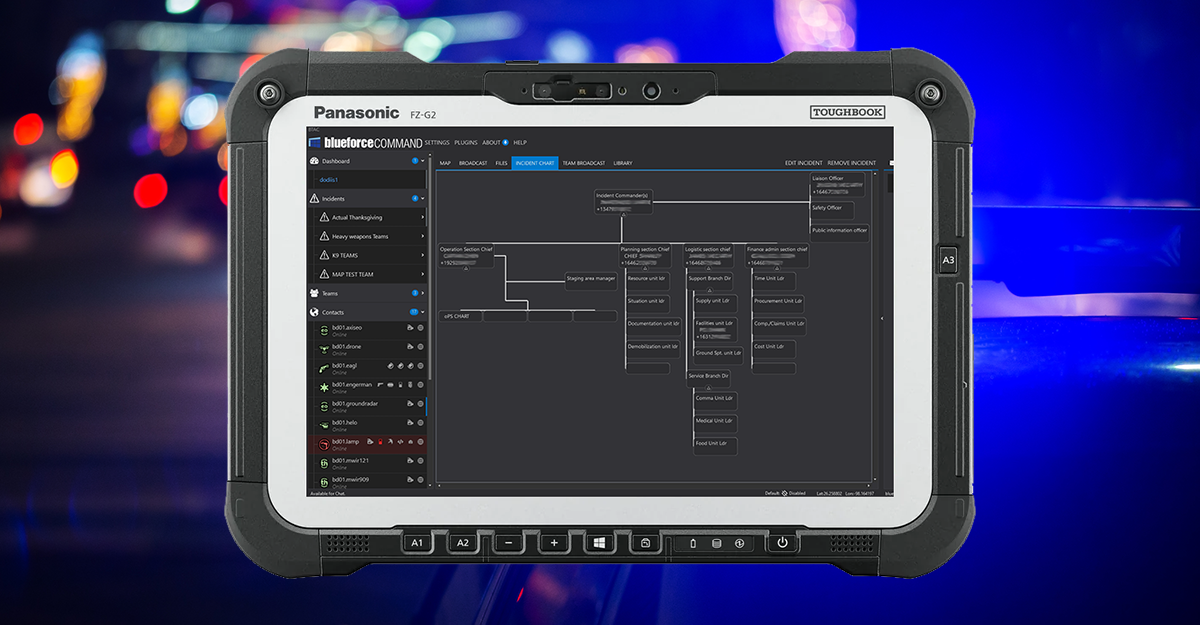
Adaptive Incident Command Module for BlueforceCOMMAND
Incidents and the subsequent emergency responses can be chaotic, especially when they involve multiple agencies and organizations that need to work together to respond to the crisis. In such situations, there may be confusion about roles and responsibilities, communication breakdowns, and a lack of coordination. Shortly after 9/11, the U.S. government commissioned programs that ultimately led to the National Incident Management (NIMS) framework which defines protocols and processes to help manage the chaos and ensure that the emergency is responded to effectively. One of the processes is the Incident Management System, or ICS.
ICS is a standardized approach to the management of emergency incidents. It is used by public and private organizations in the United States and internationally to coordinate response efforts during emergencies. The ICS is designed to be flexible, so it can be used to manage any type of emergency, from natural disasters to accidents and public health crises. The ICS is organized into a hierarchy, with each level of the hierarchy responsible for specific tasks and functions. At the top of the hierarchy is the incident commander, who is responsible for overall management of the incident. Other key positions in the ICS include command staff, general staff, and supporting organizations. The ICS is designed to be scalable, so it can be used to manage small incidents with just a few people, or large incidents with hundreds or even thousands of responders.
While ICS was most assuredly built to scale up, and also scale down, technology implementations to date have been somewhat rigid and unforgiving of “in the field” adaptation. Blueforce is proud to announce our new Adaptive Incident Command module for BlueforceCOMMAND, our forward common operational picture for Windows and HTML5 browsers. Our new Adaptive Incident Command module was designed and built to be flexible and responsive to the needs of any emergency situation. The goal of Adaptive Incident Command is to effectively manage resources and coordinate the response efforts of multiple agencies and organizations in order to minimize the impact of the emergency on the community. This includes establishing clear lines of communication, setting up incident command centers, and implementing effective incident action plans.
The Blueforce Adaptive Incident Command module is a flexible, scalable approach to managing emergencies that allows incident commanders to adjust their strategies and tactics as the situation evolves. Some benefits of using adaptive incident command include:
- It allows incident commanders to quickly respond and adapt to changes in the emergency situation, rather than being bound by a rigid, pre-determined plan.
- It allows for the integration of new information and perspectives as the incident unfolds, leading to more effective decision-making.
- It helps to ensure that the response to the emergency is coordinated and effective, with all stakeholders working towards the same goals.
The most important feature of our new Adaptive Incident Command module is the ability to embrace communications paths of a highly diverse group of responding agencies. Originally built using the ICS 207 model, Blueforce has enabled ICS hierarchies to be adapted on the fly. These adaptations can be saved for future responses so as to enable a “library” of “current best approaches” to discrete incident types to include special events, active shooter, and hostage rescue. Features of these new tools include:
- The Incidents tool allows for the creation and in the field modification of custom ICS templates.
- Incidents are initiated with an Incident Commander(s) plus the second layer of “Section” chiefs.
- Blueforce TEAMS may be nested under discrete Sections using simple drag and drop actions.
- Section Chiefs may manage and modify their “branch” which is then shared across all “branches” of the hierarchy.
- The Incident Commander and/or Section Chief may leverage a one-click send of messages and images to one or all responders in a specific hierarchy. Messaging includes Blueforce messages, Jabber/XMPP clients, and SMS/MMS for non-Blueforce users.
- Our new Incident Registration tool allows for the send of a QR code and/or link for responders to self-register for the incident without the need to come into the Incident Command post. Incident Commanders may then drag and drop resources onto any team and/or assigned as a Section Chief.
The Blueforce Incident Command module for BlueforceCOMMAND is entering beta testing now. If you would like to learn more, fill out our CONTACT ME form or call us at +1 866-960-0204.


